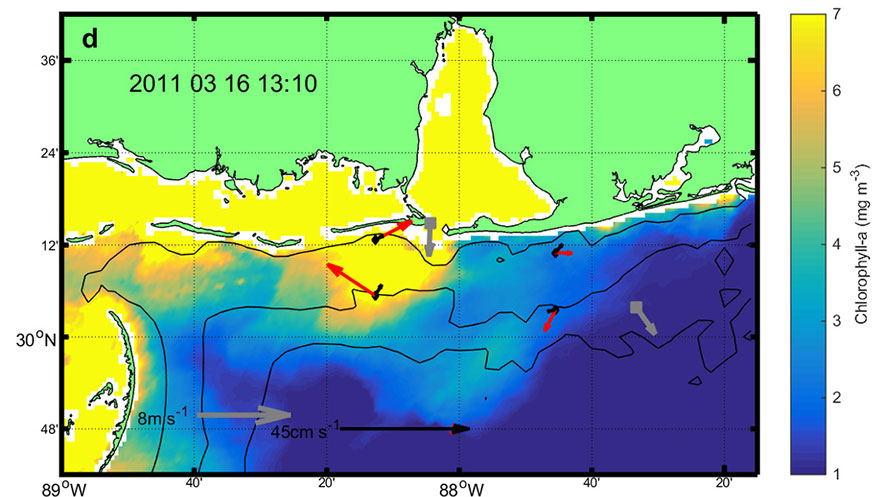Scientists monitored a major river discharge event in Mobile Bay in March 2011 to better understand how such inputs affect Gulf of Mexico nearshore water transport.
The river discharge formed a very shallow surface layer (less than 2 meters thick) that had, at times, a clockwise recirculation, altering how material exiting the Bay was dispersed and preventing offshore material from moving onshore. The shallow nature of the river plume allowed relatively light wind to rapidly alter the plume’s structure and coastal currents despite high river discharge levels. They published their findings in the Journal of Geophysical Research: Oceans: The coupled estuarine-shelf response of a river-dominated system during the transition from low to high discharge.
There was a lot of uncertainty about where Deepwater Horizon oil would go as it approached coastlines. Mobile Bay has one of the largest river discharge volumes in the continental US, frequently forming surface plumes during the transition from estuarine to shelf environments. Freshwater from river discharge exiting estuarine systems and entering the Gulf contributes to the stratification or layering of the coastal ocean, which can influence water biogeochemistry. Topographical changes along regional coastlines adds complexity to understanding plume behavior.
Lead study author Brian Dzwonkowski explained, “The northern Gulf of Mexico has inlets that act as the primary means of exchange between estuaries and the Gulf and understanding how these bodies of water interact is critical for understanding where material like oil in water will go.” The study team collected in-situ data on water level, salinity, and velocity during a transition from low to high river discharge and compared these data with regional satellite imagery. The researchers’ measurements yielded a rare, spatially comprehensive look at plume evolution and demonstrated that Mobile Bay plume structure and dynamics are critical to regional circulation during the spring season – a peak river discharge period.
The study was the first to identify a bulge region and associated anticyclonic circulation created by buoyant discharge from Mobile Bay, which researchers noted has significant implications on transport and fate of river discharge and associated materials. Wind forcing significantly influenced the plume’s structure, with downwelling easterly winds elongating the plume westward and upwelling westerly winds reversing and widening the plume. Even during large outflow conditions, low winds were able to modify plume structure and fate.
This work focused on improving knowledge about coupled estuarine-coastal ocean response around the mouth of Mobile Bay, a major source of river discharge to the Mississippi Bight (coastal waters from Louisiana to the Florida panhandle). Dzwonkowski explained, “This study improves our understanding of coastal processes that involve complex interactions between freshwater river outflow and the adjacent coastal ocean that can determine the transport pathways of river discharge materials moving into and out of an estuary. When the plume circled back it provided a means of water/material retention for the estuary.” He said that studying, monitoring, and mapping the transport pathways of the Mobile Bay plume under various conditions would provide insights on how materials such as oil, suspended sediments, and nutrients move and how to improve coastal community resilience through better disaster preparation.
The study authors are Brian Dzwonkowski, Kyeong Park, and Renee Collini.
Datasets for this publication are publicly available through various sources including the Gulf of Mexico Research Initiative Information & Data Cooperative (GRIIDC). Other data locations are http://www.mymobilebay.com, http://oceancolor.gsfc.nasa.gov/cms/, and http://disl.org.



